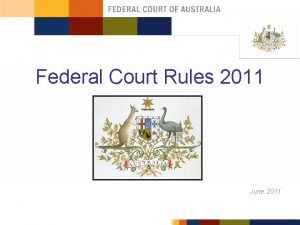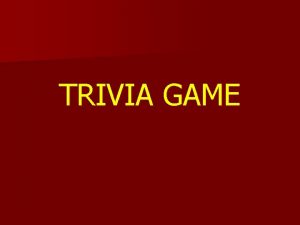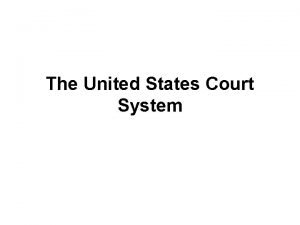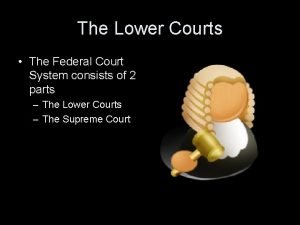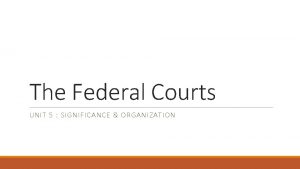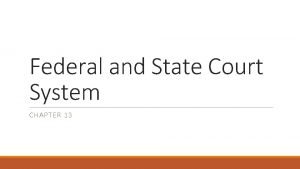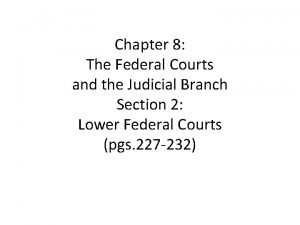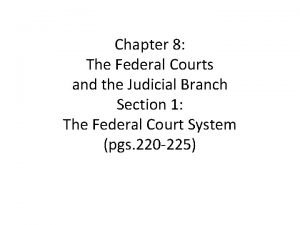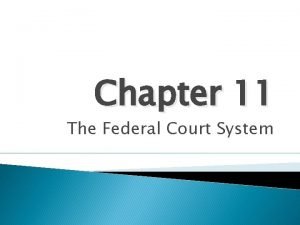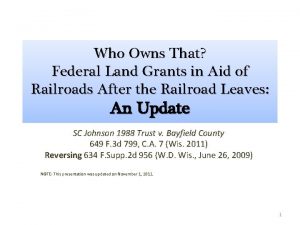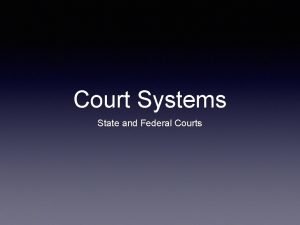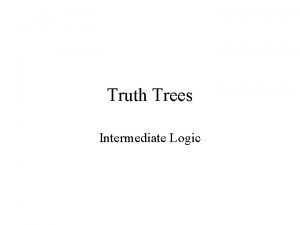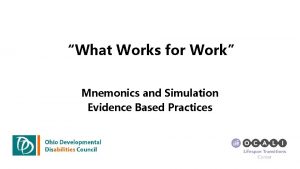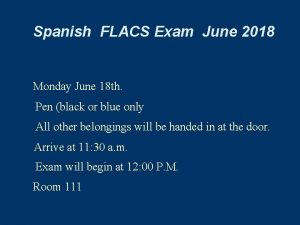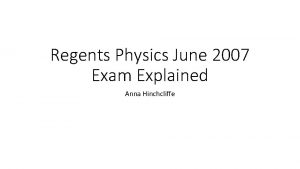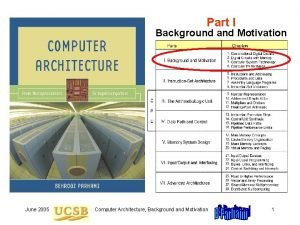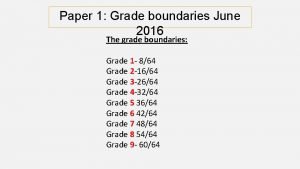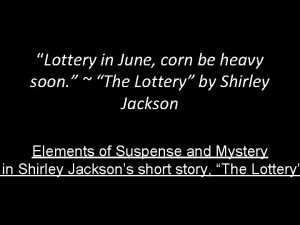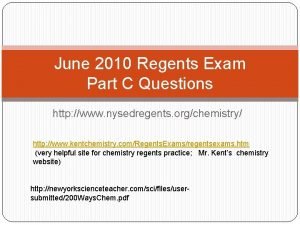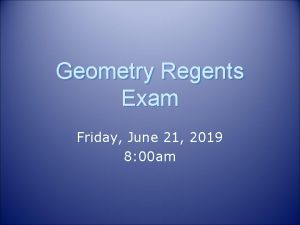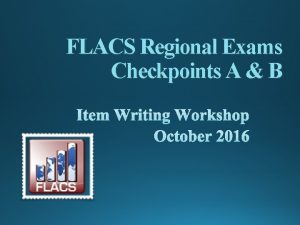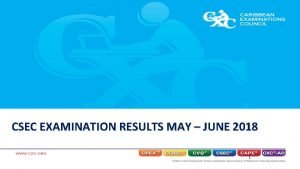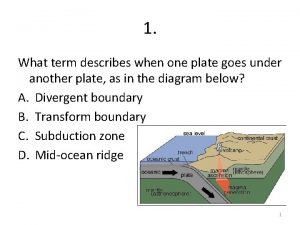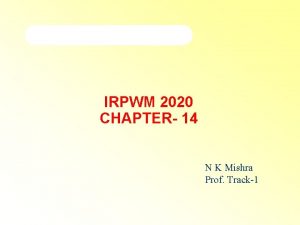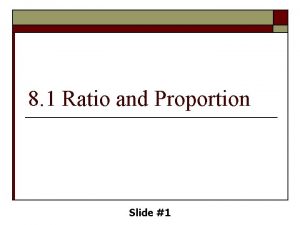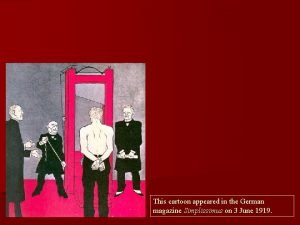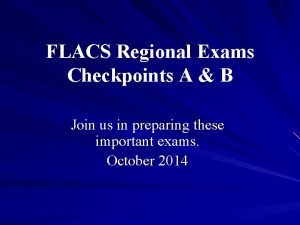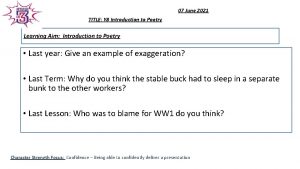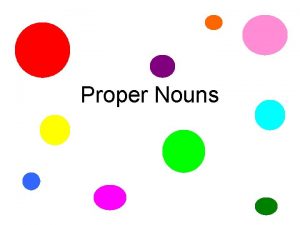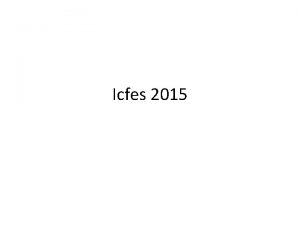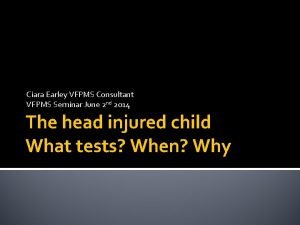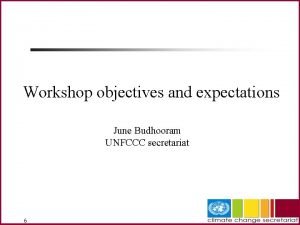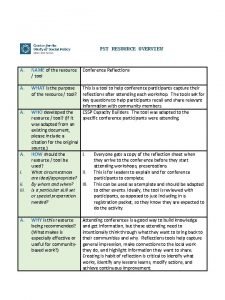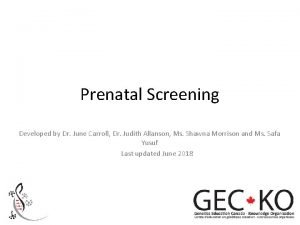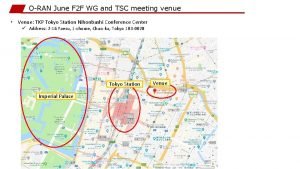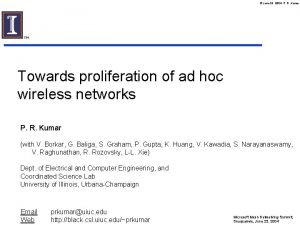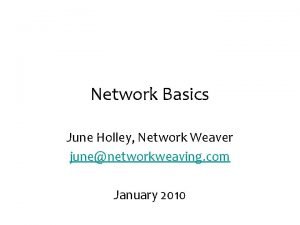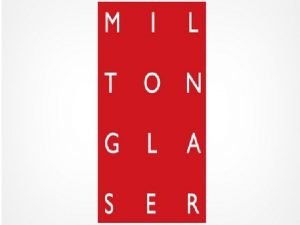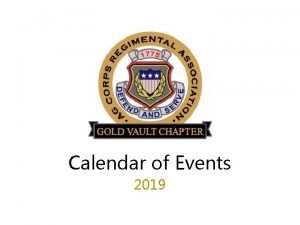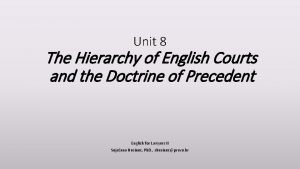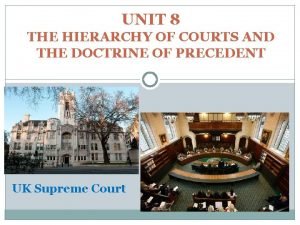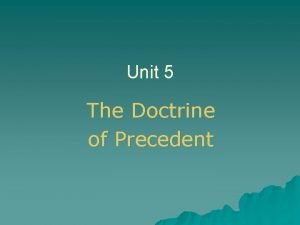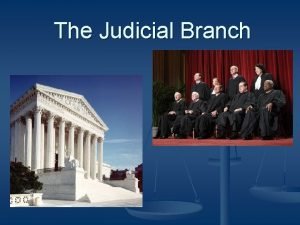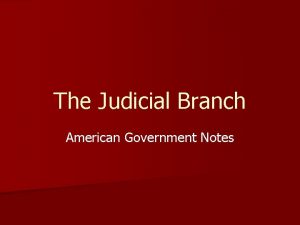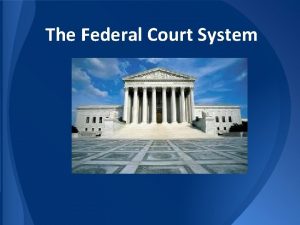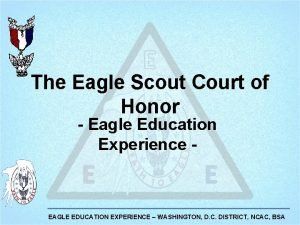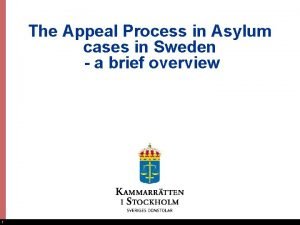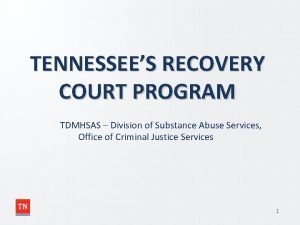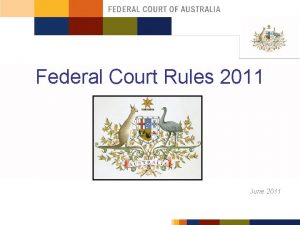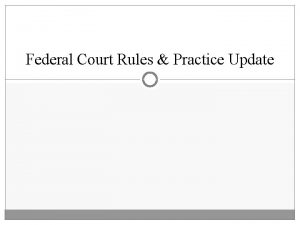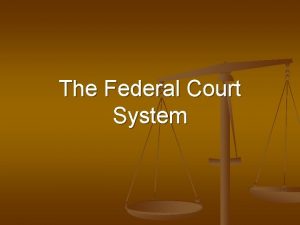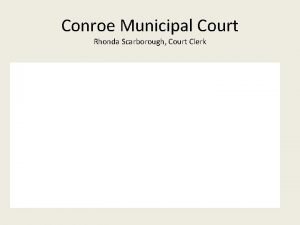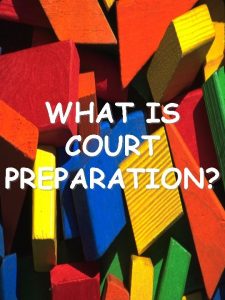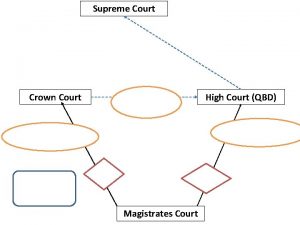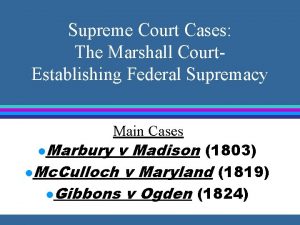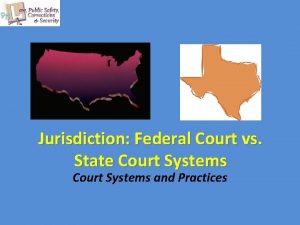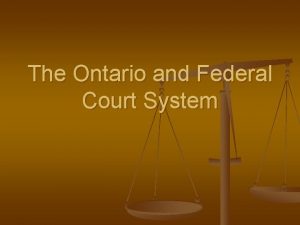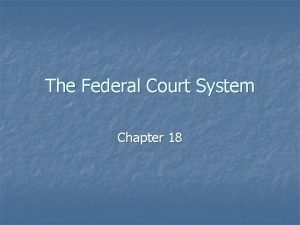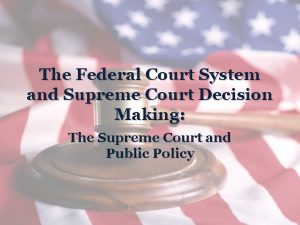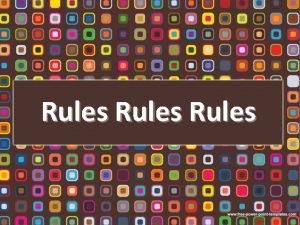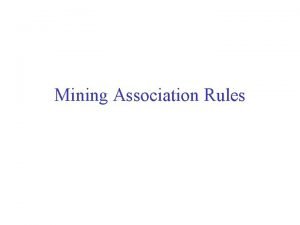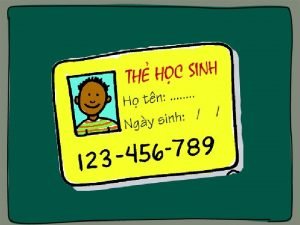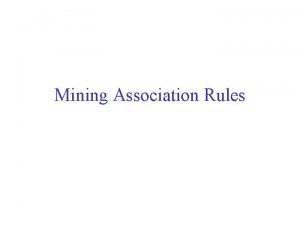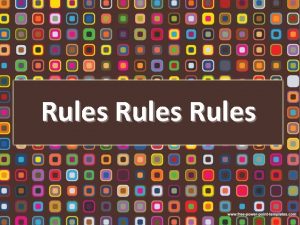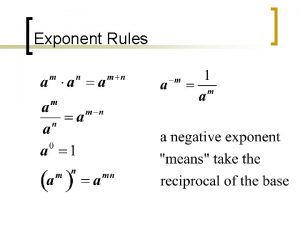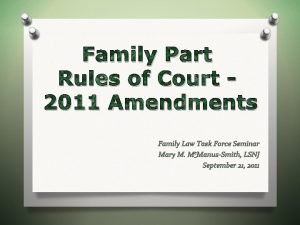Federal Court Rules 2011 June 2011 1 Federal



















































































- Slides: 83

Federal Court Rules 2011 June 2011 1

Federal Court of Australia Act 1976 Section 37 M Overarching purpose: • • • just determination of all proceedings before the Court efficient use of resources available efficient disposal of the Court's overall caseload disposal of all proceedings in a timely manner resolution of disputes at a cost that is proportionate to the importance and complexity of the matter The power to make Rules of Court must be exercised or carried out, in the way that best promotes the overarching purpose 2

Second premise • Continuation of Docket System • Flexible Case Management 3

Stylistic Changes Plain English drafting: • Passive to active voice • Gender neutral language • Removal of archaic terms: Notice of Motion = interlocutory application Tutor = litigation representative Traverse = denial Rules are directed at the litigants, not the Court: • “A party may apply…”, not “the court may order…” • Rules, not Orders • Administrative directions removed from Rules 4

Rule 8. 01 (1) A person who wants to start a proceeding in the Court’s original jurisdiction must file an originating application in accordance with Form 15. 5

General Powers of the Court • Division 1. 3 – The Court can exercise any powers in (or implied in) the Rules • Rule 1. 34 – power to dispense with compliance with the Rules • Rule 1. 35 – power to make orders inconsistent with the Rules • Rule 1. 40 – the Court can exercise powers of its own initiative 6

Structure of Rules Chapter 1 - Introductory provisions Chapter 2 - Original jurisdiction – proceedings generally Chapter 3 - Original jurisdiction – special classes of proceedings Chapter 4 - Appellate jurisdiction Chapter 5 - Judgments, costs and other general provisions Chapter 6 - Disciplinary Schedule 1 - Dictionary Schedule 2 - Powers of Registrars Schedule 3 - Costs 7

Structure of Rules • 6 Chapters – each Chapter divided into Parts • each Part divided into Divisions – each Division divided into Rules Chapters Parts Divisions Rules 8

Uh, what happened to the Forms? They’re not included as a schedule anymore…? Solicitor No, no they’re not. The forms are now ‘approved forms’ – approved by the Chief Justice pursuant to rule 1. 52(2) and published on the court’s website. Federal Court Officer 9

Transition • Provided for in Rule 1. 04 • To apply to a proceeding started in the Court on or after the commencement date • Also apply to any step in a proceeding commenced before the commencement date, if that step is taken after the commencement date – unless the Court orders old Rules continue to apply - R. 1. 04(3) 10

Great. So does this mean will there be two sets of Rules running – one for matters commenced before the New Rules, and one for matters commenced after? Solicitor Nope. All new proceedings and all new steps in old proceedings will come under the New Rules. Unless a Judge or Registrar orders otherwise, of course… Federal Court Officer 11

Other Rules • New Rules do not replace separate rules for: – Bankruptcy – Corporations – Admiralty • Harmonised Rules largely unchanged 12

Documents • Part 2 - Registry and documents – General registry practices • Div 2. 2 – Documents – Rules 2. 11 – 2. 16 – formal matters eg: • need to comply with Rules • approved forms and practice notes • contents of document heading and footer etc. 13

Documents • Div 2. 3 – lodging and filing documents – Rule 2. 26 – Registrar may refuse to accept document – Rule 2. 27 – when document will not be accepted for filing • • not substantially complete do not comply with Rules not properly signed direction that it not be accepted 14

Example of a Form Usual details – court, registry, division, file number Titles for 2 or more parties. Names of parties are put in the schedule on the second page Parties are on the left hand side First page of document 15

Example of a Form Usual details again Second and other parties named here Last page of document (where there are multiple applicants or respondents) 16

Example of a Form Name and role of filing parties Details for fax and email included Footer section on first page of document 17

Starting Proceedings Part 8 • Div 8. 1 – originating applications – Rule 8. 01 sets out the way proceedings are commenced – Rule 8. 02 Applicant’s genuine steps statement • To be filed at same time as originating application if Part 2 of Civil Dispute Resolution Act applies Genuine what statement? 18

A Genuine Steps Statement must comply with section 6 and 7 of the Civil Dispute Resolution Act 2011. It will be filed in certain types of proceedings – such as consumer protection – and details what steps have been taken to resolve the dispute before it reaches the Court. It only needs to be filed in a proceeding to which Part 2 of the Civil Dispute Resolution Act applies. Federal Court Officer 19

Genuine Steps Statement – Rule 8. 02 • Section 6 of the Civil Dispute Resolution Act • Must include: – – – – summary of the issues in dispute; date on which the dispute arose; statement of the steps taken by the applicant to try to resolve the dispute and the date on which each step was taken; respondent’s response to each step and the date on which each response occurred; if the applicant claims that the respondent’s response was not a genuine step — the reasons why this is claimed; if no steps were taken — the reasons why; if any party proposed that the parties refer the dispute to an ADR process — a statement to that effect and details thereof 20

Starting Proceedings – Rule 8. 03 – contents of application – Rule 8. 06 – originating application to be accompanied by statement of claim or affidavit – Rule 8. 07 – personal service on named respondents 5 days before 1 st return date 21

Starting Proceedings • Div 8. 3 – amendments to originating application – Rules 8. 21 and 8. 22 • applicant to apply for leave to amend originating application • No provision for amendment of originating application without leave 22

Form 15 • Action heading, other than action number, has moved to the left hand side of the page • Deals with the formalities first. Advises: – the respondent that if the respondent or a lawyer on his or her behalf does not attend the Court at the appointed time then orders may be made in his or her absence – that a notice of address for service must be filed before attending Court or taking any other steps in the matter – the time, date and place for the first directions hearing 23

Directions Hearings • Return date entered on originating application upon filing (Rule 5. 01) • Originating application must be served before first directions hearing • Notice of Address for service and genuine steps statement to be filed before first return date • Party / party’s lawyer must attend on first return date • Directions which the Court may make provided for in Rule 5. 04 • Intention is that the Court to take control immediately originating application is filed 24

Service • Definition of ‘file’ is now ‘file and serve’ unless the context indicates otherwise • Consequently the Rules are usually silent on service of documents 25

Setting aside an application – Rule 13. 01 party may apply to set aside original application or service of original application • application to set aside with supporting affidavit must be filed at same time as notice of address for service • retains the procedure previously provided for by the conditional appearance, while dispensing with the conditional appearance itself 26

Responding to an application – Rule 11. 06 – filing an address for service • must be filed by any respondent wishing to defend a claim • must be filed before filing any other document • contents of address for service prescribed by Rule 2. 16 – Rule 5. 03 – filing of Respondent’s genuine steps statement • must be filed if applicant has filed a genuine steps statement 27

Submitting notices Part 12 – Rule 12. 01 party who does not want to contest relief sought may file notice stating that fact, also stating whether party wants to be heard on costs • Must be filed before return date or within 14 days after being served with notice of appeal • May be withdrawn with leave 28

Cross-claims and third party claims Part 15 – Rule 15. 01 – establishes respondent’s right to make cross-claim – Rule 15. 04 – time for filing a notice of crossclaim – Rule 15. 10 – conduct of cross-claims • Cross-claims are no longer part of the defence but to be a free-standing document, as for an originating application 29

Cross-claims • Div 15. 2 – Amendments to cross-claims • No amendments without leave – Rule 15. 18 once leave is given, party has 14 days to amend from date order is made, if no other time is stipulated in order 30

Pleadings Part 16 • Div 16. 1 – deals with content of pleadings, including formalities – – Rule 16. 01 – provides formalities Rule 16. 02 – layout and content of pleadings Rule 16. 02(1)(d) – pleading to state material facts Rule 16. 03 – pleading a fact if necessary to meet an express denial – Rule 16. 07 – replaces ‘traverse’ with ‘denial’ 31

Pleadings • Div 16. 2 – Striking out – Rule 16. 21 party may apply to strike out all or part of a pleading • Div 16. 3 – Progress of pleadings – Rule 16. 32 defence to be filed within 28 days after service of statement of claim 32

Pleadings Don’t forget that if you are the respondent in a matter to which the Civil Dispute Resolution Act applies, you will, by the time you file your defence, have already filed your genuine steps statement in accordance with Rule 5. 03. Federal Court Officer 33

Pleadings • Div 16. 4 – Particulars – Rule 16. 43 condition of mind includes knowledge as fact that must be pleaded if relied on – Rule 16. 43(2) if party pleads another party ought to have known something, must give particulars of facts or circumstances from which other party ought to have acquired knowledge – Rule 16. 45 better particulars only ordered if: • not sufficient notice of case to be answered; and • prejudiced in conduct of case 34

Pleadings • Div 16. 5 – amendments to pleadings – Rule 16. 51 allows amendment once without leave at any time before close of pleadings unless previous amendment with leave • Further amendment permitted before close of pleadings with consent of all parties – Rules 16. 55 and 16. 56 consequential amendments – Rules 16. 58 to 16. 59 method and time for amending a pleading 35

Admissions Part 22 – Rules 22. 01 – 22. 07 – provides for: • notices to admit facts and documents • notices to dispute the truth of any fact or dispute the authenticity of any document • deemed admissions • withdrawal of admissions • judgments on admissions 36

Interlocutory applications Part 17 – Rule 17. 01 – interlocutory application to state briefly but specifically each order sought – Rule 17. 02 – interlocutory application need not be accompanied by affidavit in limited circumstances • Must be served at least 3 days before hearing of application 37

Summary Starting Proceedings & Pleadings • Rules to accommodate Civil Dispute Resolution Act • No amendment of originating applications (including cross-claims) without leave • Respondents do not file an appearance – address for service to be filed instead • Now 28 days to file defence • Pleadings – knowledge as a fact must be pleaded if relied upon – particulars of facts and circumstances required if a party pleads that another party ought to have known something • File = file and serve 38

Discovery • Div 7. 3 – discovery before proceeding: – To allow identity of prospective respondent to be ascertained – To determine whether prospective applicant has right to obtain relief against prospective respondent – Rule only allows discovery from prospective respondent 39

Discovery within an action Part 20 – Discovery and inspection of documents – Rule 20. 01 allows documents to be withheld on the ground of public interest immunity – Rule 20. 02 allows a person to maintain the protection of privilege in the face of a discovery order 40

Discovery within an action • Div 20. 2 – Discovery – Rule 20. 11 – no discovery unless necessary for the determination of issues in the proceeding – Rule 20. 12 – no discovery unless Court has made order for discovery – Rule 20. 13 – sets out method of applying for order for discovery 41

Discovery within an action – Rule 20. 14 – Standard discovery – Rule 20. 15 Non-standard and more extensive discovery: • Allows a party to identify criteria outside standard for discovery where appropriate • Application must be supported by an affidavit – Discovery by: – Category – Electronic format – Using discovery plan 42

Discovery within an action – Rules 20. 16 – 20. 22 method of making discovery: • Rule 20. 17(2)(a) discovery can be made by category • Rule 20. 20 continuing obligation to make discovery – limited in that a party is not obliged to discover any document created after the proceeding started, if the party is entitled to claim privilege 43

Discovery within an action – Rules 20. 23 – 20. 25 discovery from a non-party – Rule 20. 24 sets out obligations of the nonparty to file a list of document in accordance with Rule 20. 17 • Div 20. 3 – deals with production of documents 44

Subpoenas Part 24 • Provisions for subpoenas are the same as the old rules • New Forms – Form 43 A Subpoena to give evidence – Form 43 B Subpoena to produce documents – Form 43 C Subpoena to give evidence and produce documents 45

Summary Discovery • Discovery before proceeding only from prospective respondent • Protection of privilege enshrined within the Rules • Distinguish between standard and nonstandard discovery • Obligations of non-party specified • Three different forms for subpoenas 46

Expert and other evidence Part 23 – Experts • Div 23. 1 – Court appointed experts – Rule 23. 01 – method of appointment and payment – Rule 23. 02 – contents of expert’s report – Rule 23. 04 – ability to adduce answering experts’ reports – can only be adduced with leave of the Court 47

Expert and other evidence • Div 23. 2 – Experts retained by a party – Rule 23. 11 party can only call expert at trial if a report complying with Div 23. 2 has been provided to all parties – Rule 23. 12 party to provide all prospective experts with any practice note dealing with guidelines for expert witnesses – Rule 23. 13 sets out requirements regarding contents of report 48

Alternative Dispute Resolution (ADR) • Parties required to consider options as early as possible (Rule 28. 01) – Court to facilitate implementation of those options • Options available: – an arbitrator – a mediator – some suitable person appointed to conduct an ADR process 49

Alternative Dispute Resolution (ADR) • Parties empowered to apply to the Court for referral and for consequential orders (Rule 28. 02) • ADR to be carried out in accordance with the Rules • Applications to terminate 50

Alternative Dispute Resolution (ADR) • Arbitration is a more formal process than mediation or ADR and is dealt with differently in Division 28. 2 • Arbitrator may refer a question of law and may review an award • An arbitrator’s award may be registered • Parties are not empowered to apply to terminate arbitration or arbitrator’s appointment 51

Alternative Dispute Resolution (ADR) • Mediation (Division 28. 3) and ADR (Division 28. 4) are treated in like fashion • Not dissimilar to the current Rules 52

Alternative Dispute Resolution (ADR) International arbitration • Division 28. 5 – addresses the International Arbitration Act – Rule 28. 43 – applications to stay an arbitration – Rule 28. 44 – applications enforcing a foreign award – Rule 28. 45 – applications for relief under the UNCITRAL Model Law – Rule 28. 46 – applications for subpoenas – Applications under specific sections of the International Arbitration Act 53

Alternative Dispute Resolution (ADR) Referral to a referee • Rules continue to provide a process for the referral of a proceeding to a referee • Rules are similar to Order 72 A of the current Rules 54

Expert and other evidence Part 29 – Evidence • Div 29. 1 – affidavits – Rule 29. 08 – affidavit to be served 3 days before its intended use – Rule 29. 02 – form of affidavits • page numbering • signatures • annexures – Rule 29. 03 – affidavits must not contain frivolous or vexatious material 55

Expert and other evidence • Div 29. 1 – Affidavits – Rule 29. 04 – swearing of affidavit for person with a disability – Rule 29. 06 – acceptance despite irregularity – Affidavits must be in accordance with Form 59 – Certificates of compliance no longer required • Div 29. 2 – evidence taken on commission 56

Summary Expert and other evidence • More extensive in setting out formal details of expert reports • Additional expert reports can only be adduced with leave • More guidance regarding expert reports 57

Chapter 3 – Original Jurisdiction Special classes of proceedings • • • Judicial Review Referrals from High Court Fair Work Intellectual Property Native Title Human Rights Migration Act Taxation Appeals from decisions other than courts (eg AAT) 58

Appeals from decisions of bodies other than courts Part 33 • Div 33. 2 – AAT appeals – Rule 33. 12 – commencing appeal – Rule 33. 13 – application for extension of time – Rule 33. 14 – amendment without leave – Rule 33. 20 – cross-appeals – Rule 33. 21 – notices of contention 59

Appeals from decisions of bodies other than courts Form Title Notes 75 Notice of Appeal From a Tribunal • old Form 55 A 76 Notice of Cross-Appeal • new form 77 Notice of Contention • new form 60

Appeals from decisions of bodies other than courts • Contents of appeal books, submissions and lists of authorities consistent with Practice Notes APP 1 and APP 2 – Rules 33. 23 to 33. 28 61

Native Title proceedings • Div 34. 7 – Native Title proceedings – Rule 34. 101(2)(b) – clarifies 2 types of forms • Rules • Schedule to the Native Title (Federal Court) Regs - “a Form in the Schedule” – Rule 34. 103(2) – originating applications (general rules dealing with commencing proceedings in Part 8 apply) 62

Native Title proceedings • Joinder of parties to main application after relevant period – Rule 34. 105 • General rules applicable re cultural or customary concerns • Appeals from National Native Title Tribunal now dealt with under Part 33 – Appeals from decisions of bodies other than courts 63

Leave to appeal Part 35 • Div 35. 1 – oral applications for leave to appeal from interlocutory judgments – Rule 35. 01 - party may apply orally for leave to appeal from interlocutory judgment or order at time judgment or order is made 64

Leave to appeal • Div 35. 2 – written applications for leave to appeal • Applies to both interlocutory judgments and final judgments – Rule 35. 12 documents to accompany application for leave to appeal include judgment or order with reasons (if published) and draft appeal – Rule 35. 13 time for filing application for leave now 14 days from when judgment pronounced or order made 65

Leave to appeal – Rule 35. 14 – procedure for applying for extension of time to seek leave to appeal – Rule 35. 15 – service of application for leave to appeal • now within 2 days of filing 66

Leave to appeal • Div 35. 3 - ending early applications for leave to appeal and applications for extension of time – Rule 35. 31 – withdrawal with agreement of parties (this has the effect of an order dismissing the application and may impact on costs) – Rule 35. 32 – respondent may apply for application to be dismissed – Rule 35. 33 – party to seek certain orders in event a party is absent when matter called on for hearing 67

Appeals Part 36 Div 36. 1 – Institution of appeals – Rule 36. 01 – content of appeal – Rule 36. 03 – 21 day time limit – Rule 36. 05 – applications for extension of time – Rule 36. 09 – security for costs 68

Appeals Form Title Notes • Must be accompanied by 67 Application for extension of time 122 Notice of Appeal – judgment or orders from which the appeal is brought – reasons for judgment – an affidavit – draft appeal Rule 36. 05(3) • form used for instituting an appeal 69

Appeals – Rule 36. 10 – amendments • allow an amendment once without leave within 28 days from filing • amendment made by filing a supplementary notice • amendments after the 28 days must be with leave 70

Appeals • Div 36. 2 – cross-appeals and notices of contention – Rule 36. 21 – cross-appeal filed within 21 days – Rule 36. 24 – notice of contention within 21 days • Div 36. 3 – parties and intervenors • Div 36. 4 – dealing with certain applications on the papers • Div 36. 5 – preparation and filing of appeal books and submissions – Mirrors provisions of Practice Note APP 2 71

Appeals TIMELINE – Div 36. 5 – Practice Note APP 2 Service of Notice of Appeal - within 7 days to request an indexing - within 28 days to submit drafts of: • index to Part A • Part B Registrar approves drafts to Part A and Part B - within 14 days to file • Part A (including documents) • Part B 72

Appeals TIMELINE – Div 36. 5 – Practice Note APP 2 Number of days before hearing of appeal Documents 20 business days Appellant’s written submissions, chronology, and list of authorities 15 business days Respondent’s written submissions, chronology, and list of authorities 10 business days Any Appellant’s submissions in reply 5 business days Appeal Book Part C 73

Appeals • Div 36. 6 – ending of appeals – Rule 36. 72 notice of objection to competency must be filed within 14 days of service of notice of appeal – Rule 36. 73 discontinuance of appeal • without leave prior to the hearing of the appeal • leave required at or after the hearing 74

Summary Appeals • Rules do not differentiate between written applications for leave to appeal from interlocutory and final judgments/orders • Application for leave to appeal must be accompanied by judgment/order, with reasons if available • Now 14 days to appeal • Notice of appeal to state if appeal brought by leave and attach the order granting leave 75

Costs Part 40 • Div 40. 1 – general matters relating to costs – Rules 40. 01 and 40. 02 – types of costs orders – Rules 40. 03 to 40. 08 – general matters inc: • Reserved costs • Liability for lawyer misconduct • Costs improperly, unreasonably or negligently incurred • Reduction in costs 76

Costs • Div 40. 2 – taxation of costs – Rule 40. 17 – bill of costs – Form 127 – Rule 40. 19 – service of bill of costs – Rule 40. 20 – taxing officer to make estimate of costs in every matter – Rule 40. 21 – procedure for objection to estimate 77

Costs – Rule 40. 25 notices of objection to be filed and served on parties interested in the bill not later than 14 days before date set for taxing bill – Rule 40. 26 response to notice of objection to be filed and served within 5 days before date of taxation – Rule 40. 34 only review from decision of taxing officer is review by the Court 78

Costs – short form bills • Div 4. 3 – Short form bills – Rules 40. 41 and 40. 42 – short form bill on winding up applications (Corporations) • Now includes an amount for dismissal – Rules 40. 43 and 40. 44 – short form bills on migration matters • Div 40. 4 – maximum costs at directions 79

Costs schedule – Schedule 3 • Schedule 3 – costs schedule – simplified – fewer items – attendances and dealt with as one item – preparation of documents dealt with as one item – allowance for delegation and supervision – method of costing where client has not been charged on a time-costing basis 80

Summary Costs • • Some costs provisions moved into different parts New forms to assist practitioners Estimate procedure no longer discretionary Notice of objection to estimate must be filed not later than 14 days before taxation date • Changed time frames for filing notice of objection to bill of cost, and notice of response • Only form of review is review by the Court • Provision made for costs on the dismissal of an application for winding up 81

Summary Costs • Significant changes in costs schedule – – far simpler / fewer items attendances dealt with in one item preparation of documents dealt with in one item correspondence includes letters, emails, text messages, instant messages – allowance for delegation and supervision / research for legal question / electronic document management – Item 12 – method of costing in a matter where client – has not been charged on time costing basis 82

Questions? 83
 Federal court rules 2011
Federal court rules 2011 Is there a basketball court above the supreme court
Is there a basketball court above the supreme court Us circuit court map
Us circuit court map Federal court system structure
Federal court system structure Us federal
Us federal Chapter 13 federal and state court systems
Chapter 13 federal and state court systems Federal district court map new york
Federal district court map new york Dual court system answer key pdf
Dual court system answer key pdf What court helps congress exercise its power
What court helps congress exercise its power Federal court structure
Federal court structure State courts us
State courts us Federal and state court systems
Federal and state court systems Shorter truth table method
Shorter truth table method Unlike traditional production rules, association rules
Unlike traditional production rules, association rules 30 days has september
30 days has september Flacs exam
Flacs exam June 2010 physics regents answers
June 2010 physics regents answers June 2005 calendar
June 2005 calendar June 2016 grade boundaries
June 2016 grade boundaries Good morning 1 june
Good morning 1 june Lottery in june corn be heavy soon irony
Lottery in june corn be heavy soon irony Danswer
Danswer Welcome june blessings
Welcome june blessings English language paper 1 2021 june
English language paper 1 2021 june Life orientation grade 7 term 2 notes
Life orientation grade 7 term 2 notes Good morning welcome june
Good morning welcome june June 2018 geometry regents answers
June 2018 geometry regents answers Flacs checkpoint b french exam
Flacs checkpoint b french exam Cxccxc results 2018
Cxccxc results 2018 Tobias spears
Tobias spears Lenore hetrick pictures
Lenore hetrick pictures June cheetah wegener
June cheetah wegener Foreshadowing in the lottery
Foreshadowing in the lottery June canavan foundation
June canavan foundation Liz owns stock in nar heating/cooling
Liz owns stock in nar heating/cooling 19.06.2008 nasa
19.06.2008 nasa January 2018 chemistry regents answers
January 2018 chemistry regents answers Irpwm june 2020
Irpwm june 2020 June 20 2008
June 20 2008 German cartoon 1919 treaty of versailles
German cartoon 1919 treaty of versailles June's journey
June's journey Good morning please
Good morning please Flacs writing rubric
Flacs writing rubric Summary period: june 2021 poem
Summary period: june 2021 poem Battle of midway june 1942
Battle of midway june 1942 Singer
Singer Elephant riding in phuket texto completo respuestas
Elephant riding in phuket texto completo respuestas June too soon july stand by
June too soon july stand by In june
In june The daily nightfall prayer that rizal used to participate
The daily nightfall prayer that rizal used to participate June 22 to july 22
June 22 to july 22 June 6 1944
June 6 1944 Workshop expectations
Workshop expectations 1215 king
1215 king June preschool newsletter
June preschool newsletter June 23
June 23 Dr june carroll
Dr june carroll Tsc timetable
Tsc timetable June safety tips
June safety tips June 23
June 23 April may june july
April may june july January 2012 chemistry regents
January 2012 chemistry regents John 20:19-22
John 20:19-22 Holy june
Holy june Companies in june
Companies in june 1 june children's day
1 june children's day Head start of greater dallas
Head start of greater dallas Dr june james
Dr june james Network weaver
Network weaver Milton glaser biography
Milton glaser biography June ward
June ward 2019 june calendar
2019 june calendar Victorian court hierarchy
Victorian court hierarchy Court hierarchy in uk
Court hierarchy in uk Levels of court uk
Levels of court uk Doctrine of precedent
Doctrine of precedent Us court system chart
Us court system chart The dual court system in the u.s. means
The dual court system in the u.s. means Hersay in court
Hersay in court Us circuit court map
Us circuit court map Charging and
Charging and Surrender at appomattox court house significance
Surrender at appomattox court house significance Migration court of appeal stockholm
Migration court of appeal stockholm Tennessee drug court programs
Tennessee drug court programs
